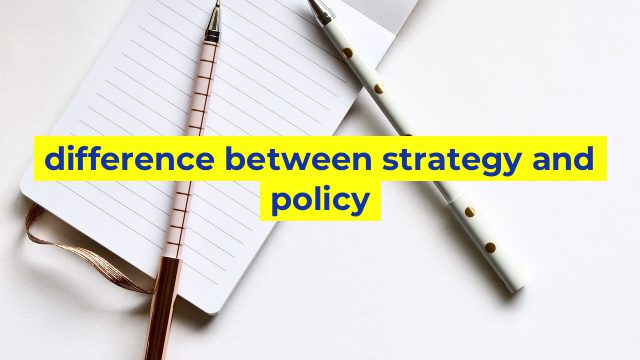The Difference Between Strategy and Policy: Understanding the Principles
Every business has objectives, goals, and plans for achieving success, and these are often expressed through strategy and policy. While these terms are often used interchangeably, they actually have distinct meanings and functions. Understanding the difference between strategy and policy is essential for any business leader seeking to develop an effective and sustainable plan for growth and success.
What is Strategy?
In simple terms, strategy refers to a company’s overall plan of action for achieving its goals. It is the high-level plan that outlines the direction of the business, the objectives to be achieved, and the tactics that will be used to achieve them. Strategy is often developed with a long-term focus and considers external factors like market trends, competition, consumer behaviours, and industry trends. A solid strategy should be flexible and adaptable to changing circumstances.
What is Policy?
Policy, on the other hand, is a set of guidelines, rules or principles that dictate how a business is run on a day-to-day basis. It is a more specific set of procedures and protocols that define how operations are executed and how decisions are made. Policies generally have a short-term focus and are designed to ensure compliance with legal and regulatory requirements, mitigate risk, and provide consistency in how the organization operates.
The Key Differences Between Strategy and Policy
There are several key differences between strategy and policy that set them apart:
1. Focus: Strategy has a long-term focus on achieving goals and gaining competitive advantage, while policy has a short-term focus on ensuring compliance and maintaining consistency.
2. Level of Detail: Strategy is a broader and more general plan, while policy is more specific and detailed.
3. Scope: Strategy encompasses the entire business, while policy often focuses on individual departments or functions.
4. Flexibility: Strategy is flexible and adaptable to changing circumstances, while policy is rigid and less flexible.
The Importance of Understanding the Difference
Understanding the difference between strategy and policy is crucial for successful organizational management. A sound strategy aligns all aspects of the business, from resources and capabilities to processes and procedures, towards achieving long-term goals. Policies, on the other hand, help to ensure that these processes and procedures are consistently executed, reducing operational risks and improving performance. Without a clear understanding of the difference between these two concepts, a business can easily become mired in inflexible procedures and lose its long-term strategic focus.
In conclusion, while strategy and policy may seem similar, they actually have different functions and purposes in organizational management. As a business leader, recognizing the differences between the two and utilizing them effectively can lead to better performance, increased competitiveness, and long-term success.
Table difference between strategy and policy
| Strategy | Policy |
|---|---|
| Defines the overall plan or approach for achieving specific goals or objectives. | Specifies guidelines, principles, and procedures that guide decision-making and actions within an organization. |
| Long-term in nature and focuses on the big picture. | Short-to-medium-term in nature and focuses on specific issues or areas of operation. |
| Is a proactive approach that provides direction and purpose. | Is a reactive approach that responds to problems or issues that arise. |
| Is formulated by senior management in consultation with key stakeholders. | Is formulated at various levels of an organization by those responsible for the implementation of the policy. |
| Helps organizations stay on track and achieve their goals and objectives. | Helps organizations manage risk and maintain compliance with laws and regulations. |

